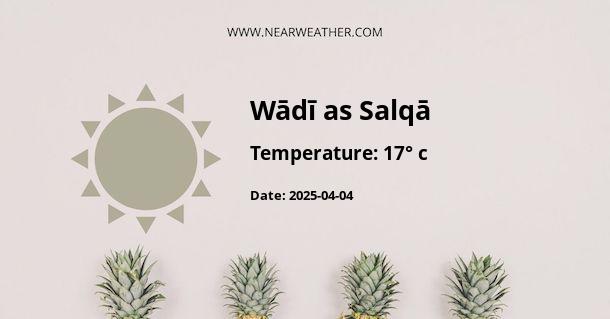Weather in Wadi as Salqa, Palestine
Wadi as Salqa, a picturesque village located in the Gaza Strip, experiences a Mediterranean climate. The region enjoys hot, dry summers and mild, wet winters, characteristic of the Mediterranean climate. The weather in Wadi as Salqa is influenced by its geographical location, with the Mediterranean Sea to the west and the Negev Desert to the east.
Annual Climate Overview
The following table provides an overview of the average weather conditions in Wadi as Salqa throughout the year:
| Month | Average High (°C) | Average Low (°C) | Precipitation (mm) |
|---|---|---|---|
| January | 17 | 8 | 115 |
| February | 18 | 8 | 95 |
| March | 20 | 10 | 65 |
| April | 24 | 13 | 15 |
| May | 27 | 16 | 2 |
| June | 29 | 19 | 0 |
| July | 30 | 21 | 0 |
| August | 30 | 21 | 0 |
| September | 29 | 20 | 1 |
| October | 27 | 17 | 15 |
| November | 23 | 13 | 45 |
| December | 19 | 10 | 90 |
From the table, it is evident that Wadi as Salqa experiences a noticeable variation in temperature and precipitation throughout the year. The summer months from June to August are hot and dry, with virtually no rainfall. Meanwhile, the winter months, particularly January and December, receive significant precipitation, contributing to the mild and wet winters in the region.
Seasonal Weather Patterns
Throughout the summer months, Wadi as Salqa experiences soaring temperatures, with July and August being the hottest months. The average high temperatures during these months can reach 30°C, making it essential for residents and visitors to take precautions to stay cool and hydrated.
Conversely, the winter months in Wadi as Salqa bring relief from the scorching heat, with January being the coldest month. The average low temperature during this period is 8°C, and significant rainfall is experienced, providing much-needed moisture for the environment.
Precipitation and Humidity
The precipitation in Wadi as Salqa is concentrated in the winter months, with December being the wettest month, receiving approximately 90mm of rainfall. The mild temperatures during the winter, coupled with the precipitation, create a favorable environment for vegetation to thrive in the region.
Furthermore, the humidity levels in Wadi as Salqa follow the pattern of the Mediterranean climate, with higher humidity levels experienced in the cooler months, particularly in January and December, when the region receives the most rainfall.
Impact of Weather on Agriculture
Wadi as Salqa's climate plays a significant role in the agricultural activities of the region. The hot and dry summers provide ideal conditions for the cultivation of crops that thrive in warm climates. Conversely, the mild and wet winters support the growth of a variety of crops due to the availability of essential moisture.
The combination of temperature variation and seasonal precipitation allows for a diverse range of agricultural activities in Wadi as Salqa, contributing to the region's economy and sustenance of its inhabitants.
Conclusion
In conclusion, Wadi as Salqa experiences a Mediterranean climate characterized by hot, dry summers and mild, wet winters. The region's weather patterns have a substantial impact on various aspects of life, including agriculture, tourism, and overall quality of life. By understanding the climate and weather dynamics of Wadi as Salqa, individuals can better prepare and adapt to the seasonal variations, ensuring the well-being and prosperity of the community.
A - Wādī as Salqā's Latitude is 31.400480 & Longitude is 34.337540.
A - Weather in Wādī as Salqā is 30° today.
A - Climate Conditions in Wādī as Salqā shows clear sky today.
A - Humidity in Wādī as Salqā is 57% today.
A - Wind speed in Wādī as Salqā is 18.43 km/h, flowing at 321° wind direction. today.
